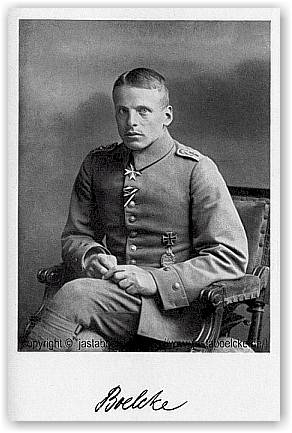Here is a picture of Oswald Boelcke: And here is a picture of Heinrich Boelcke:


Here is some information on Oswald:
OSWALD BOELCKE
40 VICTORIES
Oswald Boelcke ranks as the most important early
aviation pioneer. A natural pilot, he eventually became
the mentor and instructor of the entire German Air Service.
After initially flying two-seaters, Boelcke received one
of the first Eindeckers to arrive on the front. He quickly ran
up a respectable tally of aerial victories. However, he wasn't
satisfied with just fighting. In his spare time, he evolved a
series of rules to govern fighter pilot actions in combat. His
Dicta Boelcke is still considered the foundation of fighter tactics.
His influence helped reorganize the German Air Service in the
summer of 1916. It was clear to him that his country needed
homogeneous fighter units just like the British and French had recently
created.
Traditionally, the Eindeckers had been dispatched in twos and threes to
the observation units.
The top pilots in each unit were then assigned to fly the fighters as escorts
for the reconaissance planes.
The Germansdidn't use offensive combat patrols until after the reorganization.
Boelcke spent the summer touring all of the German fronts, choosing crack
pilots for the unit he was to create. One of those, whom Boelcke found in
Russia, was Manfred von Richthofen, later known as the "Red Baron."
In August 1916, the first few Jagdstaffeln were organized and sent to the Western Front. Jagdstaffeln literally translates to "hunting groups." These were the first German offensive combat patrols. Boelcke's unit was called Jasta 2.
Throughout August and early September, Boelcke kept his men busy by training
them to use his combat tactics. It took until mid-September for his unit
to get the requisite 12 planes to commence operational duty, so the unit
had plenty of time to practice. It soon paid off.Flying the new Albatros
D.I and D.II scouts, Jasta 2 found no equals in the sky. On their first combat
flight alone, Boelcke and his men downed 8 out of 14 British planes without
loss. One of these planes was downed by von Richthofen, his first victory.For
the next two months, Jasta 2 cleared their airspace of Allied aircraft.
Among the many aces the unit produced were Werner Voss (48 victories), Manfred
von Richthofen (80), Erwin Boehme (24), and Fritz Rumey (45).Boelcke died
after achieving 40 kills, on October 26, 1916.
Involved in a dogfight with Major Hawker's 24 Squadron, von Richthofen cut in front of Boelcke while chasing a D.H.2. Boelcke swerved upward to avoid Manfred but, in the process, brushed lightly against the lower wing of Erwin Boehme's Albatros. Boelcke's wing collapsed and he plunged to his death.Later, a British plane flew over Jasta 2's aerodrome and dropped a wreath bearing the inscription, "To the Memory of Captain Boelcke, our Brave and Chivalrous Opponent."
Some information that I stole from another site on Heinrich:
Heinrich Boelcke was born in a town in the Harz as son of Johann Boelcke in September 1916. Heinrich's father is the younger brother of the well known ace Oswald Boelcke. Heinrich shared his uncle's passion from his early youth onward, but his father, who could never quite get over his brother's death, prevented any attempts of Heinrich to live up to his desire to fly. However the military did tempt Heinrich enough to make him join the Wehrmacht in end of 1937, where he carried out his volunteer service in a tank batallion (Panzerbatallion). Starting in early 1938 he went to the Offiziersschule (officer school) in Braunschweig and finished it in 1939. After the breakout of war in september 1939 (when his father did not have influence on him anymore, since he , being a Major of the reserve, had been relocated to the front line) Heinrich Boelcke asks to be relocated to flight training. On April, 11th 1940 he is then placed in the Jagd- und Zerstoerergeschwader 23, where he survives his first war sorties. In this fighter wing (Geschwader) he found numerous good comrades, who support him in his effort to become one of the best pilots.